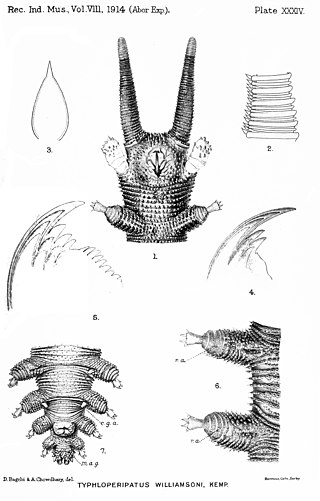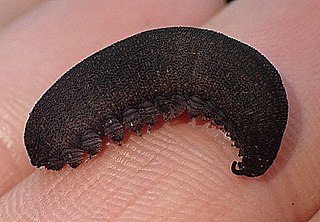
Peripatus is a genus of velvet worms in the Peripatidae family. The name "peripatus" is also used to refer to the Onychophora as a whole, although this group comprises many other genera besides Peripatus. The genus Peripatus is found in Central America, the Caribbean and northern South America. Velvet worms in this genus may have as few as 24 or 25 pairs of legs or as many as 36 leg pairs. This genus is viviparous, with mothers supplying nourishment to their embryos through a placenta.

Peripatoides indigo, the indigo velvet worm, is a velvet worm of the family Peripatopsidae. The Māori name for the velvet worm is ngaokeoke, from the Māori word 'ngaoki', to crawl.
Peripatoides suteri is a species of velvet worm in the Peripatopsidae family. This species is ovoviviparous, has 16 pairs of legs, and is endemic to New Zealand. These velvet worms range in size from 14 mm to 90 mm.

Peripatopsis is a genus of South African velvet worms in the Peripatopsidae family. The number of legs in this genus ranges from as few as 16 pairs to as many as 25 pairs and varies within species when the number is greater than 18 pairs. Velvet worms in this genus feature a last pair of legs that is rudimentary or reduced in size, mainly in males. The feet in this genus feature three distal leg papillae: two anterior and one posterior.

Typhloperipatus is a genus of velvet worm in the family Peripatidae, containing the sole species Typhloperipatus williamsoni. This genus is notable for containing the only species in the phylum Onychophora found in South Asia. This species is also striking in that this velvet worm shows no trace of eyes.

Peripatopsidae is one of the two living velvet worm families.

Ooperipatellus is a genus of Australian and New Zealand velvet worms in the Peripatopsidae family. Species in this genus are oviparous. This genus is notable as the only one in which velvet worms have no more than 14 pairs of legs: Most species in this genus have 14 leg pairs, and O. nanus has only 13 pairs, the minimum number found in the phylum Onychophora. Velvet worms in this genus are also among the smallest known, with adults often only 10 to 20 millimeters long. Species in this genus have no modified head papillae, the males feature a cruciform genital opening (gonopore), and the females feature an ovipositor. This genus contains all oviparous velvet worm species with 13 or 14 leg pairs and no modified head structures.
Metaperipatus is a genus of velvet worms in the family Peripatopsidae that contains two species found in Chile, including Metaperipatus inae. This genus was created by the American zoologist Austin Hobart Clark in 1913 to contain the type species, M. blainvillei. Authorities believe M. blainvillei is a species complex, however, and some consider M. blainvillei a nomen dubium.
Paraperipatus is a genus of velvet worms in the family Peripatopsidae. The number of legs vary within species as well as among species in this genus and can range from as few as 21 pairs up to 27 pairs in males and 29 pairs in females. The maximum number of leg pairs recorded in this genus (29) is also the maximum number of leg pairs found in the family Peripatopsidae. This genus exhibits matrotrophic viviparity, that is, mothers in this genus retain eggs in their uteri and supply nourishment to their embryos, but without any placenta. Species in this genus are found in New Guinea and Maluku, Indonesia.
Peripatoides kawekaensis is a species of velvet worm in the Peripatopsidae family. This species is ovoviviparous and has 15 pairs of legs. The type locality is in New Zealand's North Island.
Peripatus dominicae is a species of velvet worm in the Peripatidae family. Males of this species have 25 pairs of legs; females can have 28 to 31 pairs of legs, but usually have 29. Females in this species range in size from 29 mm to 56 mm in length, while males range from 17 mm to 25 mm in length. The original description of preserved specimens report that this species is usually reddish brown with a diffuse darker streak down the middle of the back, with a much paler "light grey or greyish yellow" ventral surface. Like other neotropical peripatid velvet worms, this species is viviparous, with mothers supplying nourishment to their embryos through a placenta. The type locality is in Dominica.
Ooperipatellus insignis is a species of velvet worm in the family Peripatopsidae. Females of this species range from 5 mm to 39 mm in length, while males range from 4 mm to 30 mm in length. This species has 14 pairs of legs and is found in Victoria, Australia.

Ooperipatellus nanus is a species of velvet worm in the family Peripatopsidae. This species is endemic to New Zealand and is found in the South Island.

Ooperipatellus viridimaculatus is a species of velvet worm in the family Peripatopsidae. This species is oviparous, has 14 pairs of legs, ranges from 30 mm to 50 mm in length, and is brown or orange in color with two rows of green spots along its back. It is found in the South Island of New Zealand.
Paraperipatus lorentzi is a species of velvet worm in the Peripatopsidae family. This species is a dark green-blue. Females of this species have 22 to 28 pairs of legs; males have 21 or 22 pairs of legs. Whereas the original description of this species records 19 mm as the length of a male specimen, females range from 33 mm to 60 mm in length. The type locality is in Western New Guinea, Indonesia. The validity of this species is uncertain: Although some authorities deem P. lorentzi to be a junior synonym of P. papuensis, a similar species also found in Western New Guinea, others recognize them as two separate species.
Peripatopsis sedgwicki is a species of velvet worm in the Peripatopsidae family. Also known as the Tsitsikamma velvet worm, this species has a narrow geographic distribution in South Africa but is especially abundant in the indigenous forest of the Tsitsikamma mountains. Recent phylogenetic analysis suggests that Peripatopsis sedgwicki is a species complex that contains three clades, each with a distinct geographic distribution, including at least one clade that may represent a novel species.

Peripatopsis clavigera, the Knysna velvet worm, is a species of velvet worm in the Peripatopsidae family. This species has 16 pairs of legs and ranges from 4 mm to 17 mm in length. Peripatopsis clavigera is found in subtropical or tropical moist montane forests of the Diepwalle Nature Reserve in South Africa.
Ooperipatellus nickmayeri is a species of oviparous velvet worm in the family Peripatopsidae. This species is larger than any other in the genus Ooperipatellus. With a body size exceeding 60 mm in females and 30 mm in males, these velvet worms can be more than twice as long as other species of this genus.
Diemenipatus mesibovi is a species of viviparous velvet worm in the family Peripatopsidae. This species has 15 pairs of legs in both sexes. The type locality is in Tasmania.
Diemenipatus taiti is a species of viviparous velvet worm in the family Peripatopsidae. This species has 15 pairs of legs in both sexes. The type locality is in Tasmania.








